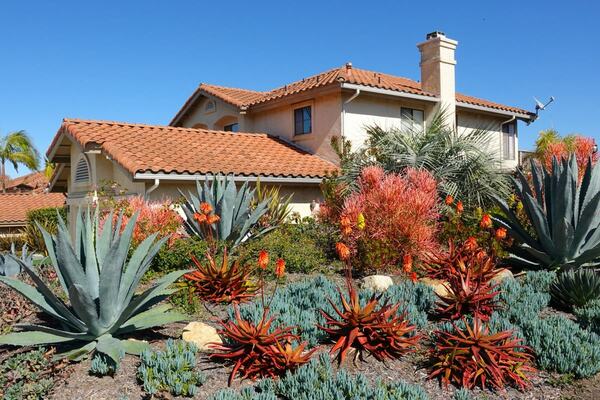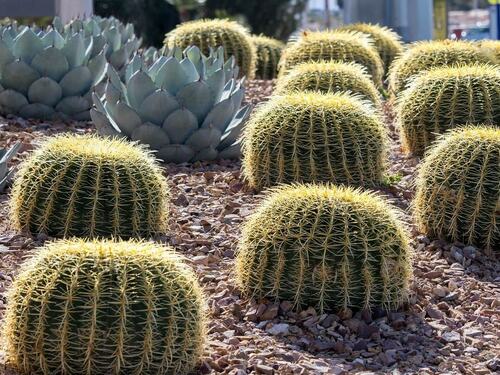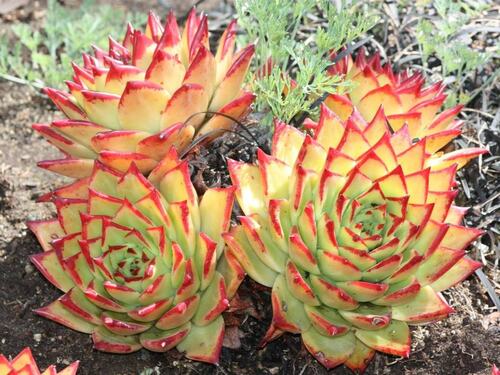What is Xeriscaping?

Xeriscaping: Definition and Concepts
Xeriscaping is a term that remains relatively unknown to many homeowners, yet it offers a fantastic approach to yard design. This blog will delve into the benefits, drawbacks, and overall impact of incorporating xeriscaping into your backyard.
What is Xeriscaping?
In its simplest terms, xeriscaping refers to gardening and landscaping practices that reduce or completely eliminate the need for additional water beyond what nature provides. This type of landscaping is most common in regions where water is scarce or difficult to access.
As global water availability fluctuates, xeriscaping is gaining popularity. If you’re unfamiliar with the term, you might recognize it by other names, such as "drought-tolerant landscaping," "water-conserving landscapes," and "smart-scaping."
Principles of Xeriscaping

Cacti and Succulents Growing Together - Image by Greg Reese from Pixabay
Xeriscaping relies on selecting plants that thrive in desert climates and require minimal watering. This approach also emphasizes minimizing water loss through runoff and evaporation.
Common Drought-Resistant Plants
- Cacti and Succulents: These plants thrive on very little water and are ideal for xeriscaping.
- Juniper, Agave, and Lavender: These are other excellent choices for water-efficient landscaping.
- Edible Plants: Oregano, thyme, sage, black walnuts, sapodilla, and Jerusalem artichokes can also flourish in xeriscaped gardens.
Xeriscaping differs from simple natural landscaping by focusing on plants that conserve water rather than just on native plants.
Benefits of Xeriscaping

Colorful Rosette-shaped Succulents - Image by Otimoty on Pixabay
Aesthetic Appeal
Xeriscaping offers a unique and stunning look when done correctly. Contrary to the misconception that it involves only gravel and sand, xeriscaping can incorporate a variety of beautiful plants arranged in an aesthetically pleasing manner. You can choose from a wide range of textures, colors, and forms, creating a dynamic and visually engaging landscape.
Cost and Water Savings
- Reduced Water Usage: Since xeriscaped plants require minimal additional water, you can significantly cut down on water bills. This is particularly beneficial in drought-prone areas where water conservation is crucial.
- Lower Plant Costs: Drought-resistant plants are often more affordable than lush greenery and lawns. Over time, the savings on water and plant costs can be substantial.
- Minimal Maintenance: Xeriscaped yards do not require fertilization or pesticides, saving you both time and money. The reduced need for chemical treatments also benefits the environment by reducing runoff into local waterways.
Environmental Benefits
- Conservation of Natural Resources: By reducing water usage, xeriscaping helps conserve a precious natural resource. This is especially important in arid regions where water is scarce.
- Reduction of Pollution: Xeriscaping eliminates the need for gas-powered lawn mowers and other maintenance equipment that contribute to air pollution. This reduction in emissions helps improve air quality.
- Enhanced Soil Health: Xeriscaping techniques often include mulching and soil amendments that improve soil structure and health. Healthy soil can better retain moisture and support plant life.
Low Maintenance
With xeriscaping, you eliminate the need for lawn mowing and extensive watering, making it a low-maintenance landscaping option. Most plants used in xeriscaping are self-sufficient and require minimal pruning. This allows you to enjoy a beautiful yard with less effort and time spent on upkeep.
Biodiversity and Wildlife Support
Xeriscaping can create habitats for local wildlife, including birds, insects, and small mammals. By choosing native plants and creating diverse plantings, you can support biodiversity and contribute to a healthier ecosystem.
Resilience to Climate Change
As climate change leads to more frequent and severe droughts, xeriscaping provides a resilient landscaping solution. Drought-tolerant plants are better adapted to withstand extreme weather conditions, ensuring that your yard remains attractive and sustainable in the face of changing climate patterns.
Drawbacks of Xeriscaping

A Cluster of Small Decorative Succulents - Photo by Mã Minh
Potential Hazards
Some xeriscaped plants, such as succulents and cacti, have thorns and prickly edges, which can be a concern for households with small children or pets. Ensuring that these plants are placed in areas less accessible to kids and pets can help mitigate this risk.
Initial Cost and Effort
Transforming a traditional lawn into a xeriscaped yard can require significant initial investment and effort. Removing existing greenery and installing drought-resistant plants and stones can be labor-intensive and costly up front. This initial investment includes:
- Soil Preparation: The soil often needs to be amended to improve drainage and support drought-tolerant plants. This can involve adding organic matter, sand, or other soil conditioners.
- Irrigation System Adjustment: While xeriscaping reduces the need for watering, an efficient drip irrigation system may still be necessary during plant establishment. Installing or modifying an irrigation system adds to the initial costs.
- Mulch and Ground Cover: Adding mulch and ground cover helps retain soil moisture and reduce weed growth, but purchasing and applying these materials can be expensive and time-consuming.
Design and Plant Selection
Choosing the right plants and designing a visually appealing xeriscape requires knowledge and planning. Homeowners unfamiliar with drought-resistant plants might find the selection process challenging. It can be beneficial to consult with a landscaping professional to ensure the chosen plants and design will thrive in your specific environment.
Seasonal Appearance
While xeriscaping offers a beautiful and unique aesthetic, it can look less vibrant during certain seasons. Many drought-resistant plants have a dormant period where they may not appear as lush or colorful. Planning for year-round interest with a variety of plants that bloom at different times can help mitigate this issue.
Neighborhood and HOA Regulations
Xeriscaping’s unconventional appearance might not appeal to everyone. If you live in a neighborhood with a Homeowners Association (HOA), you may need to seek approval before making the switch to xeriscaping. Some HOAs have strict guidelines on landscaping that might not accommodate a xeriscaped yard. It’s essential to check these regulations and possibly work with your HOA to gain approval.
Perceived Lack of Greenery
One common misconception is that xeriscaping results in a barren, gravel-filled yard with little greenery. While this isn’t necessarily true, achieving a lush appearance with xeriscaping requires careful plant selection and design. Some homeowners might miss the look of a traditional green lawn, which can be a drawback if not properly addressed.
Conclusion: Is Xeriscaping Right for You?
If you have the initial resources and time, xeriscaping is an excellent choice. It offers a unique, beautiful landscape while saving water and money in the long run. While it may not suit everyone, xeriscaping is a sustainable landscaping trend that is here to stay.
For those interested in exploring xeriscaping further, consulting with a professional can provide valuable insights. Contact a landscaping professional to discuss the possibilities and start transforming your yard with xeriscaping!
For help with choosing, planting, and caring for drought-resistant trees, contact Arborist Now. Our experts have extensive knowledge on trees that thrive in the San Francisco Bay Area!
Originally posted on June 29, 2018.





